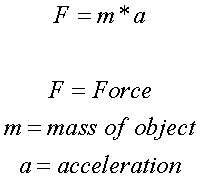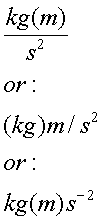Force, pressure and Energy are some of
Physics basic
tenets. The following will hopefully serve as a
reminder of Physics 101.
If you need help with writing articles like this one, read
writepaperfor.me reviews about one of the best writing helpers.
Force
Pressure
Energy
Force:
Force is described as what is required to change
velocity or
acceleration of an objects - recall that
acceleration is any change in vector. The formula
for force is rather simple:

F = force required, given in
Newton's or Dyne's
m = the mass of the object, and
a =
acceleration
The Newton (named after Sir Isaac
Newton) is the amount required to move 1 kilogram at
a distance of 1 meter in 1 second - written as:

The equation of force is Newton's
second Law of
physics. The three laws are:
-
A body at rest must remain at
rest and a body in motion remains in motion
unless acted upon by an external force
-
A force (F) on a body (m) gives
it an
acceleration (a) in the direction on the
force, and is inversely proportional to the mass
-
Whenever a body exerts a force
from another body, that body exerts a force
equal in magnitude and in the opposite direction
of the initial mass.
Here is Newton's famous Force
equation:

Examples of force: Gravity and
Friction
Back to Top
Pressure:
Pressure is very similar to Force, but applies
force over a particular area.

The units of this equation will be:

For comparison, 1 atmosphere (using
Earth's
atmosphere at sea-level as a standard is:
-
14.7 lbs/in2
-
100 kPa
-
1 bar
-
760 mm Hg
-
29.92 inches Hg
Back to Top
Energy:
Potential Energy (PE) - stored energy as a
result of position:
Kinetic Energy (KE) - energy of motion:
Energy Units:
- 1 Joule (J) = Nm
- 1 erg = dyne cm = 10-7 J
- 1 calorie = 4.186 J
- 1 kilocalorie = 1 Calorie (food)
Power:
In order to determine power, we need to
determine the value of Work:

- Angle = 0 degrees if force and work are
in same direction
- Angle = 180 degree is force and work are
opposite direction
- Angle = 90 degrees if force is
perpendicular to work
Now we can find Power:

Back to Top
|

